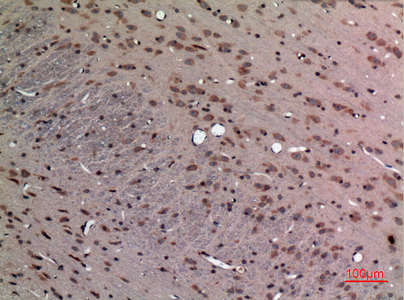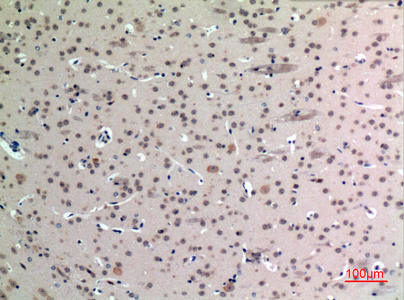FGF-12 Polyclonal Antibody
- Catalog No.:YT5161
- Applications:WB;IHC;IF;ELISA
- Reactivity:Human;Mouse;Rat
- Target:
- FGF-12
- Gene Name:
- FGF12
- Protein Name:
- Fibroblast growth factor 12
- Human Gene Id:
- 2257
- Human Swiss Prot No:
- P61328
- Mouse Gene Id:
- 14167
- Mouse Swiss Prot No:
- P61329
- Rat Gene Id:
- 170630
- Rat Swiss Prot No:
- P61150
- Immunogen:
- The antiserum was produced against synthesized peptide derived from the Internal region of human FGF12. AA range:31-80
- Specificity:
- FGF-12 Polyclonal Antibody detects endogenous levels of FGF-12 protein.
- Formulation:
- Liquid in PBS containing 50% glycerol, 0.5% BSA and 0.02% sodium azide.
- Source:
- Polyclonal, Rabbit,IgG
- Dilution:
- WB 1:500 - 1:2000. IHC: 1:100-300 ELISA: 1:20000.. IF 1:50-200
- Purification:
- The antibody was affinity-purified from rabbit antiserum by affinity-chromatography using epitope-specific immunogen.
- Concentration:
- 1 mg/ml
- Storage Stability:
- -15°C to -25°C/1 year(Do not lower than -25°C)
- Other Name:
- FGF12;FGF12B;FHF1;Fibroblast growth factor 12;FGF-12;Fibroblast growth factor homologous factor 1;FHF-1;Myocyte-activating factor
- Observed Band(KD):
- 27kD
- Background:
- The protein encoded by this gene is a member of the fibroblast growth factor (FGF) family. FGF family members possess broad mitogenic and cell survival activities, and are involved in a variety of biological processes, including embryonic development, cell growth, morphogenesis, tissue repair, tumor growth, and invasion. This growth factor lacks the N-terminal signal sequence present in most of the FGF family members, but it contains clusters of basic residues that have been demonstrated to act as a nuclear localization signal. When transfected into mammalian cells, this protein accumulated in the nucleus, but was not secreted. The specific function of this gene has not yet been determined. Two alternatively spliced transcript variants encoding distinct isoforms have been reported. [provided by RefSeq, Jul 2008],
- Function:
- function:Probably involved in nervous system development and function.,similarity:Belongs to the heparin-binding growth factors family.,subunit:Interacts with the C-terminal region of SCN9A.,tissue specificity:Brain, eye and testis; highly expressed in embryonic retina, olfactory epithelium, olfactory bulb, and in a segmental pattern of the body wall; in adult olfactory bulb, less in cerebellum, deep cerebellar nuclei, cortex and multiple midbrain structures.,
- Subcellular Location:
- Nucleus .
- Expression:
- Brain, eye and testis; highly expressed in embryonic retina, olfactory epithelium, olfactory bulb, and in a segmental pattern of the body wall; in adult olfactory bulb, less in cerebellum, deep cerebellar nuclei, cortex and multiple midbrain structures.
- June 19-2018
- WESTERN IMMUNOBLOTTING PROTOCOL
- June 19-2018
- IMMUNOHISTOCHEMISTRY-PARAFFIN PROTOCOL
- June 19-2018
- IMMUNOFLUORESCENCE PROTOCOL
- September 08-2020
- FLOW-CYTOMEYRT-PROTOCOL
- May 20-2022
- Cell-Based ELISA│解您多样本WB检测之困扰
- July 13-2018
- CELL-BASED-ELISA-PROTOCOL-FOR-ACETYL-PROTEIN
- July 13-2018
- CELL-BASED-ELISA-PROTOCOL-FOR-PHOSPHO-PROTEIN
- July 13-2018
- Antibody-FAQs
- Products Images

- Western Blot analysis of 22RV-1, BT474, SHSY5Y cells using FGF-12 Polyclonal Antibody. Secondary antibody(catalog#:RS0002) was diluted at 1:20000 cells nucleus extracted by Minute TM Cytoplasmic and Nuclear Fractionation kit (SC-003,Inventbiotech,MN,USA).

- Immunohistochemical analysis of paraffin-embedded rat-brain, antibody was diluted at 1:100

- Immunohistochemical analysis of paraffin-embedded mouse-brain, antibody was diluted at 1:100

- Western blot analysis of lysate from 22RV-1 cells, using FGF12 Antibody.



